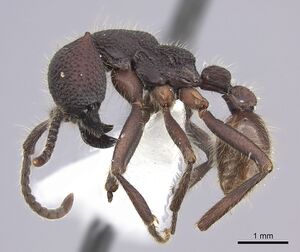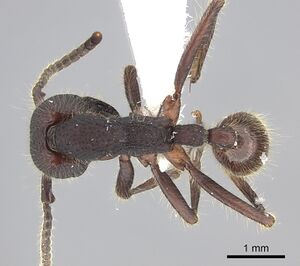Neivamyrmex sumichrasti
| Neivamyrmex sumichrasti | |
|---|---|

| |
| Scientific classification | |
| Kingdom: | Animalia |
| Phylum: | Arthropoda |
| Class: | Insecta |
| Order: | Hymenoptera |
| Family: | Formicidae |
| Subfamily: | Dorylinae |
| Genus: | Neivamyrmex |
| Species: | N. sumichrasti |
| Binomial name | |
| Neivamyrmex sumichrasti (Norton, 1868) | |
This species is only known from queens and/or workers and has yet to be associated with males.
Identification
Face densely foveolate-granular, matte; dorsum of postpetiole foveate-granular like petiolar dorsum; first gastral tergite shagreened with microreticulum, not smooth and shining; in face view posterolateral margins of head with strong triangular projections.
Distribution
Latitudinal Distribution Pattern
Latitudinal Range: 21.92913333° to 8.89147°.
| North Temperate |
North Subtropical |
Tropical | South Subtropical |
South Temperate |
- Source: AntMaps
Distribution based on Regional Taxon Lists
Neotropical Region: Costa Rica, Guatemala, Honduras, Mexico (type locality), Nicaragua.
Distribution based on AntMaps
Distribution based on AntWeb specimens
Check data from AntWeb
Countries Occupied
| Number of countries occupied by this species based on AntWiki Regional Taxon Lists. In general, fewer countries occupied indicates a narrower range, while more countries indicates a more widespread species. |

|
Estimated Abundance
| Relative abundance based on number of AntMaps records per species (this species within the purple bar). Fewer records (to the left) indicates a less abundant/encountered species while more records (to the right) indicates more abundant/encountered species. |

|
Biology
Baudier et al. (2015) studied thermal tolerances of a variety of army ant workers. Eciton mexicanum was one of a number of army ant species sampled with a life history that includes both below and above ground activities.
Jack Longino: This species is a montane specialist, occurring in cloud forest habitats. It is common in the Monteverde area, from 1300m on the Pacific side, across the divide, and down to 900m on the Atlantic side. I also have records from Fila Cruces near San Vito, and the 1500m site (Finca Murillo) on the Barva transect. Raiding columns are normally seen during the day, and it may be a primarily diurnal forager.
Association with Other Organisms
 Explore: Show all Associate data or Search these data. See also a list of all data tables or learn how data is managed.
Explore: Show all Associate data or Search these data. See also a list of all data tables or learn how data is managed.
- This species is a associate (details unknown) for the phorid fly Ecitomyia wheeleri (a associate (details unknown)) (Quevillon, 2018).
- This species is a associate (details unknown) for the phorid fly Ecitophora collegiana (a associate (details unknown)) (Quevillon, 2018).
- This species is a associate (details unknown) for the phorid fly Ecitophora comes (a associate (details unknown)) (Quevillon, 2018).
- This species is a associate (details unknown) for the phorid fly Ecituncula aptera (a associate (details unknown)) (Quevillon, 2018).
- This species is a associate (details unknown) for the phorid fly Puliciphora borinquenensis (a associate (details unknown)) (Quevillon, 2018).
- This species is a associate (details unknown) for the phorid fly Xanionotum scopifer (a associate (details unknown)) (Quevillon, 2018).
- This species is a associate (details unknown) for the phorid fly Xanionotum wasmanni (a associate (details unknown)) (Quevillon, 2018).
Castes
Images from AntWeb
   
| |
| Worker. Specimen code jtlc000010262. Photographer Will Ericson, uploaded by California Academy of Sciences. | Owned by JTLC. |
Nomenclature
The following information is derived from Barry Bolton's Online Catalogue of the Ants of the World.
- sumichrasti. Eciton sumichrasti Norton, 1868a: 62, pl. 2, fig. 7 (w.) MEXICO (Veracruz).
- Type-material: syntype workers (number not stated).
- Type-localities: Mexico: Córdoba (Sumichrast), and Orizaba (Sumichrast).
- Type-depository: ANSP.
- Mann, 1926: 99 (q.).
- Combination in E. (Acamatus): Emery, 1894c: 182 (in text);
- combination in Neivamyrmex: Borgmeier, 1955: 491.
- Status as species: Norton, 1868b: 45; Norton, 1868c: 6; Mayr, 1886b: 120 (in key); Mayr, 1886d: 440; Cresson, 1887: 259; Dalla Torre, 1893: 6; Emery, 1894c: 183 (in key); Emery, 1895c: 259, Forel, 1899c: 27; Forel, 1901c: 124; Wheeler, W.M. 1908e: 410; Emery, 1910b: 25; Wheeler, W.M. 1910g: 562; Wheeler, W.M. 1914b: 41; Mann, 1926: 99; Wheeler, W.M. 1934g: 159 (redescription); Borgmeier, 1955: 491 (redescription); Kempf, 1972a: 160; Watkins, 1976: 15 (in key); Watkins, 1982: 212 (in key); Bolton, 1995b: 291; Branstetter & Sáenz, 2012: 254.
- Distribution: Costa Rica, Guatemala, Mexico, Nicaragua.
Unless otherwise noted the text for the remainder of this section is reported from the publication that includes the original description.
Description
Queen
Mann (1926) - Length 11.5 mm.
Head from the front about as long as broad, slightly broader in front than at occipital border, sides feebly rounded, occipital border emarginate, occiput and vertex with large impressed areas; vertex and front with a median longitudinal groove that becomes stronger anteriorly and terminates at posterior border of clypeus. Ocelli lacking; eyes of a single, white facet, situated a little behind middle of sides of head. Mandibles slender, thickest at middle, nearly straight, their tips obtusely pointed. Median, triangular portion of clypeus longer than broad, anterior border very feebly emarginate. Frontal carinae anteriorly rather acute above, posteriorly broad and convex. Antennal scapes robust, clavate, about half as long as head; .funiculi more slender than scape, the first joint as broad as long, the others distinctly longer than broad, the terminal slender, connate and nearly as long as the two preceding joints together. Thorax long, very gradually widened from front to rear, in profile about three times as long as deep, slightly rounded in region of pronotum, flat behind, the dorsal surface of mesonotum shallowly, though distinctly impressed at middle. Propleurae shallowly and broadly impressed. Promesonotal suture very indistinctly indicated by an impressed line; mesometanotal suture not discernible. Meta-epinotal impression distinct. Basal portion of epinotum much longer than the flat declivity, into which it broadly rounds; dorsal surface a little broader than long, strongly and broadly impressed at middle, the impression deepest posteriorly, sides behind middle subgibbous. Petiole from above transverse, not as broad as epinotum, sides very feebly divergent behind, anterior corners broadly rounded, posterior corners projecting and obtusely angulate, posterior border strongly emarginate, dorsal surface concave at middle, with rather strong convexities at sides of concave portion, then sloping and indistinctly impressed toward lateral borders; seen from the side the node is much higher than long, arcuate in front and above and emarginate on posterior outline, with the anterior portion of sides convex and the posterior concave. Gaster elongate oval. Hypopygium and pygidium submembraneous at borders, which in the former are nearly straight and in the latter triangularly excised. Sting not visible. Legs rather short, slender. Claws simple.
Gaster shining, the rest nearly opaque. Head, thorax and epinotum densely and finely punctate, the head more shallowly than the rest, and in addition with scattered, coarser punctures most conspicuous on the epinotum. Petiole densely and shallowly punctate and more shining. Gaster with distinct, irregular, separated punctures, each of which bears a moderately long, stiff, finely pointed yellow recumbent hair. Mandibles and anterior border of clypeus sparsely punctate.
Erect hairs yellow, fine and abundant on head, thorax and petiole and appendages.
Dark ferrugineous red, appendages paler, antennae yellowish.
References
- Baudier, K. M., A. E. Mudd, S. C. Erickson, and S. O'Donnell. 2015. Microhabitat and body size effects on heat tolerance: implications for responses to climate change (army ants: Formicidae, Ecitoninae). Journal of Animal Ecology. 84:1322-1330. doi:10.1111/1365-2656.12388
- Borgmeier, T. 1955. Die Wanderameisen der neotropischen Region. Stud. Entomol. 3: 1-720 (page 491, Combination in Neivamyrmex)
- Borowiec, M.L. 2019. Convergent evolution of the army ant syndrome and congruence in big-data phylogenetics. Systematic Biology 68, 642–656 (doi:10.1093/sysbio/syy088).
- Emery, C. 1894d. Studi sulle formiche della fauna neotropica. VI-XVI. Bull. Soc. Entomol. Ital. 26: 137-241 (page 182, Combination in E. (Acamatus) (in text))
- Mann, W. M. 1926. Some new neotropical ants. Psyche. 33:97-107. (page 99, queen described)
- Norton, E. 1868a. Notes on Mexican ants. Am. Nat. 2: 57-72 (page 62, pl. 2 fig. 7 worker described)
- Varela-Hernández, F., Medel-Zosayas, B., Martínez-Luque, E.O., Jones, R.W., De la Mora, A. 2020. Biodiversity in central Mexico: Assessment of ants in a convergent region. Southwestern Entomologist 454: 673-686.
References based on Global Ant Biodiversity Informatics
- Borgmeier T. 1955. Die Wanderameisen der neotropischen Region. Studia Entomologica 3: 1-720.
- Coates-Estrada, R., and A. Estrada. 1989. Avian attendance and foraging at army-ant swarms in the tropical rain forest of Los Tuxtlas, Veracruz, Mexico. Journal of Tropical Ecology 5: 281-292.
- Dattilo W. et al. 2019. MEXICO ANTS: incidence and abundance along the Nearctic-Neotropical interface. Ecology https://doi.org/10.1002/ecy.2944
- Fernandes, P.R. XXXX. Los hormigas del suelo en Mexico: Diversidad, distribucion e importancia (Hymenoptera: Formicidae).
- Fernández, F. and S. Sendoya. 2004. Lista de las hormigas neotropicales. Biota Colombiana Volume 5, Number 1.
- INBio Collection (via Gbif)
- Kempf, W.W. 1972. Catalago abreviado das formigas da regiao Neotropical (Hym. Formicidae) Studia Entomologica 15(1-4).
- Longino J. T. L., and M. G. Branstetter. 2018. The truncated bell: an enigmatic but pervasive elevational diversity pattern in Middle American ants. Ecography 41: 1-12.
- Longino J. et al. ADMAC project. Accessed on March 24th 2017 at https://sites.google.com/site/admacsite/
- Quiroz-Robledo, L.N. and J. Valenzuela-Gonzalez. 2006. Las hormigas Ecitoninae (Hymenoptera: Formicidae) de Morelos, México. Revista Biologia Tropical 54(2):531-552
- Rojas Fernandez P. 2010. Capítulo 24. Hormigas (Insecta: Hymenoptera: Formicidae). In: Diversidad Biológica de Veracruz. Volumen Invertebrados. CONABIO-Gobierno del Estado de Veracruz.
- Vásquez-Bolaños M. 2011. Lista de especies de hormigas (Hymenoptera: Formicidae) para México. Dugesiana 18: 95-133
- Watkins II, J.F. 1982.The army ants of Mexico (Hymenoptera: Formicidae: Ecitoninae). Journal of the Kansas Entomological Society 55(2): 197-247.
- Wheeler W. M. 1901. Notices biologiques sur les fourmis Mexicaines. Annales de la Société Entomologique de Belgique. 45: 199-205.
- Pages using DynamicPageList3 parser function
- Need species key
- Tropical
- Phorid fly Associate
- Host of Ecitomyia wheeleri
- Host of Ecitophora collegiana
- Host of Ecitophora comes
- Host of Ecituncula aptera
- Host of Puliciphora borinquenensis
- Host of Xanionotum scopifer
- Host of Xanionotum wasmanni
- Species
- Extant species
- Formicidae
- Dorylinae
- Neivamyrmex
- Neivamyrmex sumichrasti
- Dorylinae species
- Neivamyrmex species
- Need Overview
- Need Body Text

